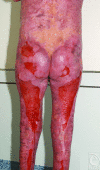CASE REPORT Febrile Ulceronecrotic Mucha-Habermann Disease
- PMID: 20697454
- PMCID: PMC2905190
CASE REPORT Febrile Ulceronecrotic Mucha-Habermann Disease
Abstract
Objective: Case report and review of the current literature about febrile ulceronecrotic Mucha-Habermann disease (FUMHD).
Methods: Review of our patient's medical records and of the current literature.
Results: The FUMHD is a rare and potentially lethal type of pityriasis lichenoides et varioliformis acuta. It is characterized by the sudden onset of ulceronecrotic skin lesions associated with high fever and systemic symptoms. Because of a high case-fatality rate it requires quick and decisive action. Only 40 cases of this severe form of the disease have been reported in the literature to date. We present the case of a 30-year-old male patient with severe FUMHD who was successfully treated in our burn intensive care unit after failed treatment at a dermatological hospital. The patient was treated with topical antiseptics, moisturizers, and artificial skin substitutes, as well as systemic immunosuppressive therapy (glucocorticoids) with which we were able to control the disease activity so that healing of the patient's skin lesions could be achieved.
Conclusion: Patients with FUMHD should be treated in a specialized center for severely burned patients. Only such centers can provide the structural and logistical capacities necessary for the treatment of such extensive superficial wounds.
Figures
Similar articles
-
A case report of febrile ulceronecrotic Mucha-Habermann disease.Transl Pediatr. 2024 Apr 30;13(4):690-696. doi: 10.21037/tp-23-520. Epub 2024 Apr 15. Transl Pediatr. 2024. PMID: 38715678 Free PMC article.
-
Febrile ulceronecrotic Mucha-Habermann disease: a case report and review of the literature.Acta Derm Venereol. 2008;88(4):350-5. doi: 10.2340/00015555-0441. Acta Derm Venereol. 2008. PMID: 18709304 Review.
-
[Febrile ulceronecrotic Mucha-Habermann disease].Rev Med Chil. 2016 Sep;144(9):1214-1217. doi: 10.4067/S0034-98872016000900017. Rev Med Chil. 2016. PMID: 28060985 Spanish.
-
Febrile ulceronecrotic Mucha-Habermann disease: a case report and review of the literature.Dermatology. 1996;192(3):277-9. doi: 10.1159/000246385. Dermatology. 1996. PMID: 8726649 Review.
-
A case of febrile ulceronecrotic Mucha-Habermann disease responsive to systemic corticosteroids.Pediatr Dermatol. 2023 May-Jun;40(3):573-575. doi: 10.1111/pde.15234. Epub 2022 Dec 27. Pediatr Dermatol. 2023. PMID: 36573550
Cited by
-
Mortality risk factors in febrile ulceronecrotic Mucha- Habermann disease: A systematic review of therapeutic outcomes and complications.Dermatol Reports. 2022 Nov 21;14(4):9492. doi: 10.4081/dr.2022.9492. eCollection 2022 Nov 21. Dermatol Reports. 2022. PMID: 36483219 Free PMC article.
References
-
- Bowers S, Warshaw EM. Pityriasis lichenoides and its subtypes. J Am Acad Dermatol. 2006;55(4):557–72. quiz 573-6. - PubMed
-
- Cozzio A, Hafner J, Kempf W, et al. Febrile ulceronecrotic Mucha-Habermann disease with clonality: a cutaneous T-cell lymphoma entity? J Am Acad Dermatol. 2004;51(6):1014–7. - PubMed
-
- Aytekin S, Balci G, Duzgun OY. Febrile ulceronecrotic Mucha-Habermann disease: a case report and a review of the literature. Dermatol Online J. 2005;11(3):31. - PubMed
-
- Dereure O, Levi E, Kadin ME. T-Cell clonality in pityriasis lichenoides et varioliformis acuta: a heteroduplex analysis of 20 cases. Arch Dermatol. 2000;136(12):1483–6. - PubMed
LinkOut - more resources
Full Text Sources


